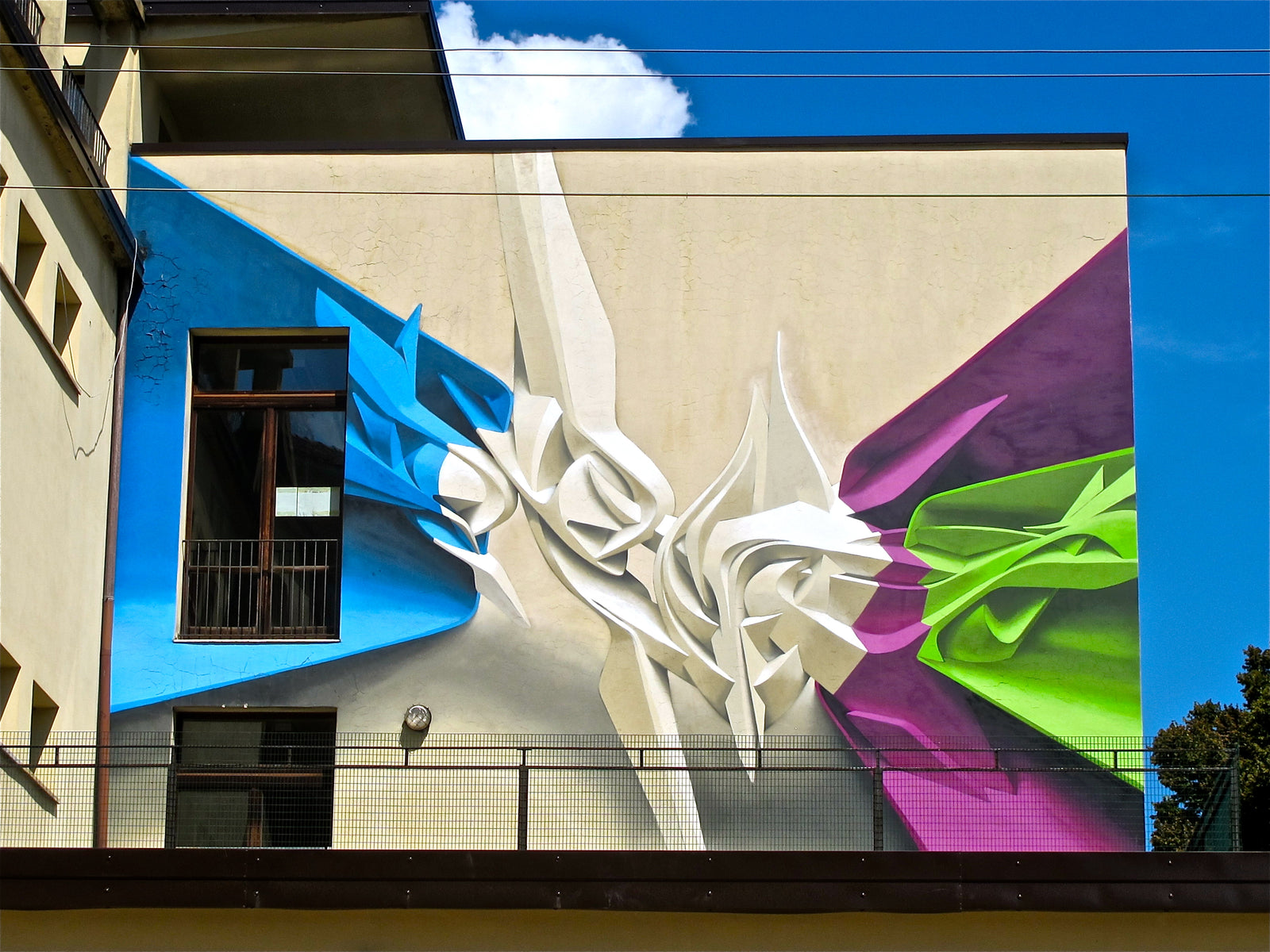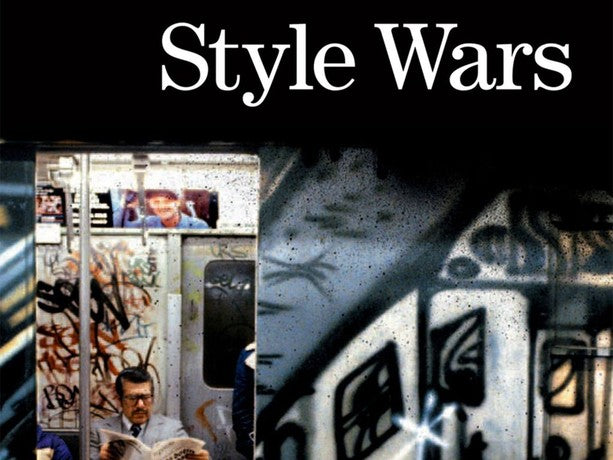In the early days of graffiti art, notoriety was prized above all else. The young writers of the 1960’s and 70’s, eager for fame and recognition, worked quick and dirty, scrawling their tags in simple letters on nearly any surface they passed. For these graffiti art pioneers, quantity always trumped quality, and legibility was king. After all, what would be the point of taking your tag “all-city” if no one could read it?
Things have changed dramatically in the years since. From the “Wild Style” of the late 1970’s and 80’s to the bold, muscular lettering of writers like Revok and Retna, a piece of graffiti art is now celebrated above all for its creator’s unique vision and artistry. Fame comes not from a wide-reaching tag, but from showcasing exceptional style, originality, and innovation, legibility be damned.

Among the contemporary street artists pushing this idea to its limit is PEETA, an Italian multidisciplinary virtuoso whose wild, abstracted graffiti language looks like it might have been stolen from some other dimension. Scroll through the PEETA photo gallery and you’ll find it’s practically impossible to pick even a single letter out of this artist’s strange, twisting designs.
Indeed, such groundbreaking new works by PEETA, the result of his self-described quest to “redesign the volumes” of the surfaces he encounters, are likely to be some of the most bizarre and beautiful pieces of mural art you’ll ever see.
“Parallel Realities”: PEETA’s Early Life and Graffiti Art Influences
Born Manuel di Rita in a small town outside Venice in 1980, PEETA’s creative spark came early. As a boy, he was fascinated by the art he saw while visiting Spain with his mother, and, in particular, by the graffiti-covered trains that ran between Venice and Trieste.
Eager to understand how such works were made, PEETA used his camera to document the train graffiti, and, soon after, decided he’d try to reproduce it himself. This led to his first work of street art, painted on a wall near his hometown when he was just 13 years old.
Such emulation and experimentation, which, in PEETA’s words, “started as a game,” soon grew into an obsession, consuming all of the young artist’s free time. Taking as his moniker a childhood nickname, PEETA began to develop his unique graffiti style by bending, stretching, and twisting the letters of his name into unrecognizable new shapes.
Inspired by by the groundbreaking work of architects like Zaha Hadid (who designed such stunning sites as the Changsha Meixihu International Culture and Art Centre and whose influence is particularly striking), PEETA went on to formally study sculpture in high school and interior and industrial design at university.
These experiences fueled PEETA’s passion for sculpture and would prove hugely influential in the development of his unique, tactile, “plastic” lettering style, the artist saying in an interview: “I learn volumes from sculpture and apply them to painting, and I project through paintings new shapes for sculptures.”
This connection between two-dimensional graffiti and three-dimensional sculpture is key to PEETA’s singular appeal, the subtle play of highlights and shadows making viewers, in PEETA’s words, “totally attracted by the plasticity of [his] works,” eager to reach out and touch the otherworldly shapes.
PEETA has since painted walls, designed sculptural installations, and headlined gallery openings around the world, showing his work in New York, Amsterdam, London, Vancouver, Paris, Basel and beyond, things coming full circle at his first solo show in Spain in 2015 -- Montana Gallery’s aptly-titled “Parallel Realities”.
An “Interruption of Normality”: How to See PEETA Art
Though PEETA’s work is often striking in its extreme contrast to the world it occupies, the artist cites the urban spaces themselves as his primary inspiration. Reminiscent of Vhils, PEETA tells Street Art 360 he strives to “mingle with the surrounding context,” from “architectural, natural, cultural, and social” points of view.
In so doing, PEETA seeks to create a “temporary interruption of normality” by disrupting the familiarity of his audience’s surroundings, sparking “a different understanding of spaces and, consequently, of reality as a whole.”

PEETA achieves this interruption in part through his use of an artistic technique called anamorphosis, through which he creates the illusion of solidity, texture, and exaggerated depth, blurring the boundaries between the real world and his graffiti. Though we tend to associate this style with the popular 3D chalk drawings of contemporary artists like Kurt Wenner, it’s a technique found in a number of classic artworks, including Hans Holbein the Younger’s “The Ambassadors”, and, in one of the world’s most stunning examples, Andrea Pozzo’s painted ceiling in the Church of St. Ignazio.
Like many of these artists, PEETA is particularly interested in what he calls “the deceptiveness of human perception,” and, in a broader philosophical sense, in “the fallacy of narrow and fixed points of view.”

A key fact to learn about PEETA, however, is that he is driven above all by a desire to explore his own identity and place in the world, the artist telling I Support Street Art: “I think it’s necessary to reimagine the surrounding world and [in so doing], the self.”
Here, PEETA makes it clear his art is that not merely intended to widen eyes. Instead, PEETA sees his work as a much more personal exploration of the self, as personified by the tangled, reimagined letters that make up his name. As such, PEETA considers his tags a form of “abstract self-portraiture”, or, as Ganzo magazine aptly described them, “Identity in 3D.”

Sculpting Emotions: New Works by PEETA
Today, PEETA continues to push boundaries and explore new forms in his art, bending genre and blending disciplines with his trademark fearless commitment, his electric forms overtaking the sides of multistory buildings, abandoned stairwells, and low-lit gallery walls, the knotted letters alien and almost glowing, like something pulled from science fiction.
Instagram’s PEETA photo gallery shows the artist busy at work on commissioned murals and gallery openings around the world, including one especially stunning series of new works by PEETA made in collaboration with Apparati Effimeri, which allows visitors to see PEETA art combined with stereoscopic 3D projections, the pairing sending viewers on an almost hallucinatory graffiti journey.

From the Vancouver Mural Fest, to the Urban Forms fest in Łódź, Poland, to Thinkspace Gallery’s “There Are No Limits” show in Sweden and New York City’s SCOPE, PEETA shows no sign of slowing, displaying his work alongside that of street art luminaries like Saner and Super A, rising stars like LA’s Michael Reeder, and the ever-impish Banksy.
But the more we learn about PEETA, the clearer it becomes that whatever new avenues he chooses to explore in his work, he will be committed to authenticity in his art and to fostering genuine emotional connections with his audience.
“Whether they can read my letters or not, they can appreciate the sensation as they view the forms,” he says. “So, I think I can say that I paint and sculpt emotions.”
Learn more about graffiti artists and techniques on the Spray Planet Blog!






Joseph Rodriguez
November 06, 2019
Instead of it being seen as A crime or A nuisance, Someone should brainstorm A legal route of expressing art for A licensed state ran & monitored program space. Instead of people just looking for recognition.
-Joe Rod LI NY